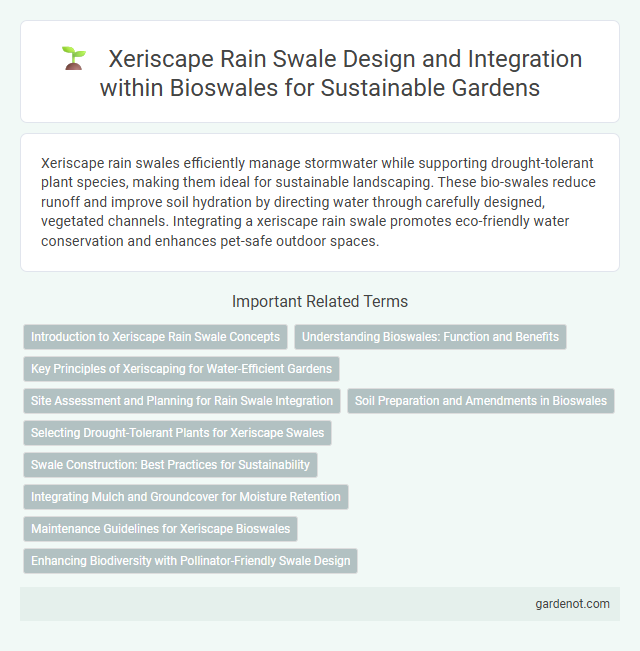Xeriscape rain swales efficiently manage stormwater while supporting drought-tolerant plant species, making them ideal for sustainable landscaping. These bio-swales reduce runoff and improve soil hydration by directing water through carefully designed, vegetated channels. Integrating a xeriscape rain swale promotes eco-friendly water conservation and enhances pet-safe outdoor spaces.
Introduction to Xeriscape Rain Swale Concepts
Xeriscape rain swales integrate low-water-use landscaping with engineered depressions that capture and infiltrate stormwater, promoting sustainable water management. These swales utilize drought-tolerant native plants and permeable soils to reduce runoff, enhance groundwater recharge, and minimize irrigation needs. Implementing xeriscape rain swales supports urban resilience by mitigating flooding and conserving water resources in arid climates.
Understanding Bioswales: Function and Benefits
A xeriscape rain swale is a sustainable landscaping feature designed to manage stormwater by directing runoff through shallow, vegetated channels that promote infiltration and reduce erosion. Bioswales improve water quality by filtering pollutants and support groundwater recharge while providing habitat for native plants and beneficial insects. Their integration into urban and residential landscapes enhances flood control, conserves water, and reduces the need for traditional irrigation.
Key Principles of Xeriscaping for Water-Efficient Gardens
Xeriscape rain swales utilize drought-tolerant plants and efficient irrigation methods to reduce water consumption in garden landscapes. Key principles include soil analysis for optimal water retention, strategic plant selection favoring native and drought-resistant species, and mulching to minimize evaporation. Proper design integrates contouring and grading to capture and filter stormwater, promoting sustainable and water-efficient environments.
Site Assessment and Planning for Rain Swale Integration
Site assessment for xeriscape rain swale integration involves analyzing soil permeability, slope gradient, and existing vegetation to determine optimal placement and design. Planning requires selecting drought-tolerant native plants and sizing the swale to maximize stormwater infiltration and minimize runoff. Proper evaluation ensures efficient water capture, erosion control, and habitat support within sustainable landscaping practices.
Soil Preparation and Amendments in Bioswales
Soil preparation in xeriscape rain swales involves grading to direct runoff efficiently while enhancing infiltration. Incorporating organic matter such as compost improves soil structure, increases moisture retention, and supports microbial activity essential for pollutant breakdown. Amendments like sand or biochar are added to optimize percolation rates and nutrient retention, ensuring sustainable plant growth and effective stormwater management.
Selecting Drought-Tolerant Plants for Xeriscape Swales
Selecting drought-tolerant plants for xeriscape rain swales ensures efficient water use and enhances soil stabilization while reducing irrigation needs. Native grasses, succulents, and deep-rooted perennials like purple coneflower and Muhly grass thrive in swales, promoting biodiversity and resilience during dry periods. Proper plant selection optimizes stormwater infiltration, minimizes erosion, and supports sustainable, low-maintenance landscape design.
Swale Construction: Best Practices for Sustainability
Xeriscape rain swale construction prioritizes the use of native drought-tolerant vegetation and permeable soil layers to maximize water infiltration and minimize runoff. Incorporating organic compost and engineered soils enhances microbial activity, promoting soil stability and nutrient retention for sustainable plant growth. Proper grading and soil compaction techniques ensure efficient water flow, preventing erosion and supporting long-term ecosystem resilience.
Integrating Mulch and Groundcover for Moisture Retention
Integrating mulch and groundcover in xeriscape rain swales significantly enhances moisture retention by reducing evaporation and improving soil hydration. Organic mulch, such as wood chips or shredded bark, creates a protective layer that conserves soil moisture and supports beneficial microbial activity. Dense, drought-tolerant groundcover plants like native grasses and succulents stabilize soil, minimize runoff, and promote sustained water infiltration in sustainable landscape designs.
Maintenance Guidelines for Xeriscape Bioswales
Xeriscape bioswales require minimal maintenance through regular inspection to prevent sediment buildup and ensure effective water infiltration. Native drought-tolerant plants in the swale need periodic pruning and replacement to maintain vegetation health and support local biodiversity. Mulching around plants reduces weed growth and moisture loss, enhancing the bioswale's sustainable water management performance.
Enhancing Biodiversity with Pollinator-Friendly Swale Design
Xeriscape rain swales designed with native pollinator-friendly plants create critical habitats that increase local biodiversity and support essential ecosystem services. These bio-swales use drought-tolerant vegetation to efficiently manage stormwater while attracting bees, butterflies, and other pollinators necessary for a healthy environment. Incorporating diverse flowering species ensures continuous bloom cycles, promoting enduring pollinator populations and enhancing ecological resilience.
Xeriscape rain swale Infographic

 gardenot.com
gardenot.com